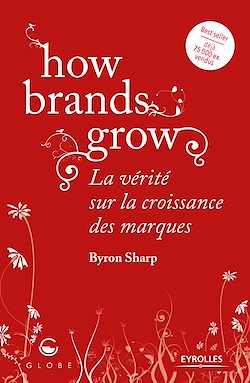Byron Sharp How Brands Grow Pdf Download

By Byron Sharp Published: Oxford University Press, 2010. How Brands Grow: what marketers don’t know is based on decades of research that has progressively uncovered scientific laws about buying and brand performance. This book is the first to present these laws in context, and explore their meaning and marketing applications. How Brands Grow: What Marketers Don’t Know Byron Sharp download B–OK. Download books for free. Download PDF How Brands Grow: What Marketers Don't Know By Byron Sharp. By soft documents of the book How Brands Grow: What Marketers Don't Know By Byron Sharp to review, you could not need to bring the thick prints anywhere you go.
Publisher : Oxford University Press, USA
Release : 2015-10-12
ISBN : 9780195596267
Language : En, Es, Fr & De
GET BOOK
Book Description :
Following the success of international bestseller How Brands Grow: What Marketer's Don't Know comes a new book that takes readers further on a journey to smarter, evidence-based marketing. How Brands Grow Part 2, by Jenni Romaniuk and Byron Sharp, is about fundamentals of buying behaviour and brand performance - fundamentals that provide a consistent roadmap for brand growth, and improved marketing productivity. Ride the next wave of marketing knowledge with insights such as how to build Mental Availability, metrics to assess the strength of your brand's Distinctive Assets and a framework to underpin your brand's Physical Availability strategy. Learn practical insights such as smart ways to look at word of mouth and the sort of advertising needed to attract new brand buyers. This book is also a must read for marketers working in emerging markets, services, durables and luxury categories, with evidence that will challenge conventional wisdom about growing brands in these markets. If you've ever wondered if word of mouth has more impact in China, if luxury brands break all the rules of marketing or if online shoppers are more loyal to brands or retailers, this book is for you. If you read and loved How Brands Grow, it's time to move to the next level of marketing. And if you haven't, get ready -- this book will change the way you think about marketing forever.
- Author: Byron Sharp
- Publisher: Oxford University Press
- Publication: 2011
How Brands Grow: What Marketers Don’t Know (HBG) is one of those business bestsellers that has fast become an absolute must-read for marketers; it has perhaps done more to shake up the world of brand marketing than anything else created or published in the last decade (see our summary of Sharp’s 2016 followup book How Brands Grow Part 2 here).
Having an opinion on HBG (which essentially comes down to whether you believe marketing is an art or science) is almost a prerequisite to credibility in marketing today. So if you do nothing else, read the speed summary and watch the TED talk below.
So what does the book actually have to say?
Authored by Byron Sharp and his colleagues at the Ehrenberg-Bass Institute, University of South Australia, and building on the seminal marketing research by Ehrenberg and Goodhart, How Brands Grow is a manifesto for evidence-based marketing, building brands based on what works in scientific practice rather than what should work in marketing theory. In addition to outlining 7 evidence-led rules for unlocking growth through brand marketing, the book busts a number of pernicious and costly marketing myths that are sometimes still peddled today; “esoteric quackery concerned with segmentation, differentiation and how buyers perceive brands (e.g. brand personality)”.
Bin the Brand Onion
For Sharp and his co-authors, marketers have made their lives unnecessarily difficult, handicapping themselves with unfounded theories of branding based on anecdotes and bad metaphors.
For example, there is little evidence to suggest that consumers want ‘relationships’ with brands, or that brands should seek to create ‘meaning’ in consumers’ lives, or that brand commitment and brand loyalty are anything more than just wishful thinking, or that brand positioning (in terms of creating a differentiated ‘brand personality’) is a productive endeavour. When you look at the data, what works in branding is surprisingly simple – making the brand easy to buy – by maximising it’s physically availability and creating an attractive and memorable set of distinctive brand assets; sensory and semantic cues such as colours, packaging, logo, design, taglines and celebrity endorsements that make the brand easy to like, memorise and recall.
Mass Marketing Works
Moreover, when you look at the evidence, there is no reason to complicate your marketing lives with targeting and segmenting customers, whether based on lifestyle, category usage or brand loyalty. Positioning brands for particular target segments is as futile as brand positioning by creating a differentiated brand ‘personality’. Successful growth brands have universal appeal, and mass marketing with a reach-optimised single simple message, rather than being a mass mistake, is still the most effective way to drive sales.
Want Loyalty? Get a Dog
And there’s one more lesson from scientific analysis of marketing data – you don’t need to complicate your lives with a costly customer retention/loyalty program – because they don’t work and have no impact on growth. Customer loyalty is largely a myth (customers are at best ‘promiscuous loyals’ – flitting fickle-like between alternative rival brands based on availability – 72% of Coke drinkers also buy Pepsi (UK)). Likewise for brand commitment – people buy brands out of habit, not commitment. The evidence-led path to growth is simple; market penetration by recruiting ever more new brand users in habitual purchase. And forget marketing designed to increase purchase frequency, it doesn’t work (difference in market share can nearly always be explained in terms of differences in market penetration, not purchase frequency) – focus instead the light and occasional users that account for much of your sales and growth (the typical Coca-Cola buyer in the UK buys Coke just once a month).
How Brands Grow
If there is one top insight in HBG it’s this; the secret to growing your brand is to build ‘market-based assets’ and these come in two flavours – maximised distribution (physical availability) – and clear and distinctive branding using sensory cues (colours, logo, design…) that are easy to remember (“distinctive memory structures”) and recall. The real challenge of marketing is all about availability – available in the mind and in the store.
Seven Rules for Brand Growth
After several bruising rounds of marketing myth-busting, HBG outlines 7 scientifically derived rules for brand growth.
- Continuously reach all buyers of the category (communication and distribution) – avoid being silent
- Ensure the brand is easy to buy (communicate how the brand fits with the users life)
- Get noticed (grab attention and focus on brand salience to prime the users mind)
- Refresh and build memory structures (respect existing associations that make the brand easy to notice and easy to buy)
- Create and use distinctive brand assets (use sensory cues to get noticed and stay top of mind)
- Be consistent (avoid unnecessary changes, whilst keeping the brands fresh and interesting)
- Stay competitive (keep the brand easy to buy and avoid giving excuses not to buy (i.e. by targeting a particular group)
Implications for Innovation
The implications of HBG for innovation are clear; once you’ve spotted a market opportunity, and a product solution, innovation should continue with building a set of distinctive brand assets; the sensory and semantic cues such as colours, logo, packaging, design, tag-lines and celebrity endorsements that will make the brand easy to memorise and recall. The key to brand innovation is to achieve brand distinctiveness with sensory brand assets (and not conceptual brand differentiation).

The second major implication for brand innovation is that brands should focus as much on innovative distribution solutions as product innovation – the secret to innovation success is to get your distinctive innovation in front of as many eyes as possible. So how can you innovate to maximise distribution (think Nespresso, Apple Retail, American Apparel). Ultimately, Brand Genesis is all about innovating availability – mental availability in terms of creating brand assets that can become memory structures based and physical availability, maximising distribution or owing a distribution channel. In contrast, any time spent on market segmentation or targeting on anything other than needs is time wasted, and efforts to construct a brand ‘personality’ or attempts to make meaning with customers is futile (most memorable quote in the book “Rather than striving for meaningful, perceived differentiation, marketers should seek meaningless distinctiveness”).
The Brand Genetics Take
Like many others, we think How Brands Grow: What Marketers Don’t Know is a crucial book for brand marketers. Whilst we’ll not be drinking the radical empiricist KoolAid it champions (we’re firm believers that there’s nothing so practical as good theory – good theory inspires, guides and motivates), Sharp’s scientific rigour cuts a deadly swathe through much marketing nonsense. It’s a reality-check to realise that consumers perceive very weak differentiation between rival brands, and buy more out of habit and availability rather than commitment and loyalty. And it’s a useful reminder that successful branding (and innovation) should concern itself with creating and managing a set of sensory brand assets. The implication that brand innovation should be as much about distribution innovation as product innovation is also particularly useful.
Apart from epistemological quibbles (limits of inductivism and naive empiricism) and psychological nuances (brand choice as risk mitigation), where we do differ from HBG is in our conviction that the ultimate answer to how brands grow is innovation, rather than managing mental and physical availability. Sure, innovation always has a negative short-term impact on your brand (your ability to extract margin), since it requires investment, but brands exist in competitive and changing environments where opportunities change. As Kapferer concludes in Strategic Brand Management: Brands are rejuvenated by new products matching new needs, not by advertising. Would it have been smarter of Coke to invest in increased availability rather than buy VitaminWater for $4.1bn? Or Budweiser to have invested in more availability than innovating with Bud Light. We think not. Moreover, unlike the dry and scientific management of availability, innovation has the capacity to energise and motivate a brand.

We’re also not convinced about the futility of ‘brand personality’, particularly as a tool for creating the consistent and distinctive brand assets that HBG recommends. Consumers may not want to bond or have relationships with trademarked packaged goods, but personification can be a useful creative tool, especially if you are co-creating with consumers. We are social creatures with an evolved social mind – and that means we tend to personify everything from pets to objects – we personify the world around us as it helps us understand that world. Personification can be a useful creative tool in brand development, since it allows marketers to carve brands at the mind’s evolved joints and make brands more memorable and communicable.
That said, HBG has some important lessons for brand marketing – and yes, we will be burning that brand onion.
Appendix: The New Laws of Marketing
HBG also posits a number new scientific inviable marketing laws (insights)
The Double Jeopardy Law: Brands with smaller market shares have fewer buyers, who are also less loyal (loyalty declines with market share)
Law of Buyer Moderation: Regression to the mean of purchase behaviour over time; heavier users become lighter, lighter users become heavier buyers, and non-buyers begin to buy the brand
Byron Sharp How Brands Grow Pdf Download 2017
Duplication of Purchases Law: All brands, within a category, share their customer base with other brands in line with the size of those other brands